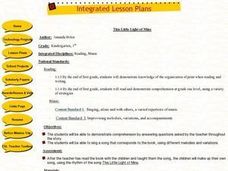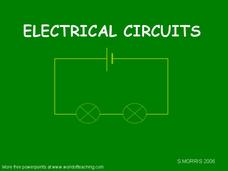Rice University
College Physics for AP® Courses
Take a look at an organized physics course. The 34-section electronic textbook covers material in AP® Physics 1 and 2. Teachers use the text to supplement lectures and have the class work through the labs. Each section contains...
PHET
Faraday's Law
Could a flux capacitor really work? An engaging simulation encourages scholars to investigate Faraday's law. They experiment with various speeds, magnitude, voltage, and different-sized coils. Hopefully experimenters will be able to...
PHET
Faraday's Electromagnetic Lab
"But still try, for who knows what is possible." - Michael Faraday. Faraday's advice features in a simulation that permits pupils to play with a bar magnet in order to make a light bulb glow connecting electromagnetic induction to...
Curated OER
This Little Light of Mine
Elementary schoolers discover how electricity travels and create an electron flow through a closed circuit. They work together to make a closed circuit and observe the electricity being made. This outstanding lesson plan is well worth...
Curated OER
Electrical Circuits
Wow! Here is a coherent and cleverly designed tool for teaching physical scientists about electric circuits. Animations help learners to visualize what is happening within the parts of a circuit. Components are displayed to teach them...
Bonneville
A Simple Circuit
Heat up a lesson on solar energy by building a circuit for a cooling fan. Given a solar module and a DC motor, scholars develop hypotheses for how to make the fan turn. They test out their hypotheses, and then draw a circuit diagram to...
Bonneville
What is Electricity and How Do We Use It?
Use some electrifying lessons to learn about electricity. Future scientists discover the history of electricity and the basics of electric circuits. They learn how to read an electricity bill and then create circuits to power a fan,...
PBS
Locker Lights
Light up a locker for a more festive hallway! Scholars learn about electric currents, LEDs, and switches, then experiment with their own circuits. They use the circuits to design and build locker decorations that light up when turned on...
Bonneville
Illuminate Me: Merging Conductive Sewing, Technology, and Solar Power
Sew up a unit on solar energy with a hands-on project. Groups sew LED lights on clothing using conductive thread. Solar modules attached to a helmet provide the energy for the lights. A final presentation gives learners the opportunity...
Bonneville
Using a Multimeter to Analyze a Solar Circuit: Measuring Current and Voltage—Calculating Power and Resistance
Power to the people who understand electricity. A simple experiment teaches pupils how to set up an electric circuit that includes a solar module and how to measure voltage and current using a multimeter. They calculate power and...
Bonneville
Designing a Solar Phone Charger
What a bright idea! Working in groups, scholars design a solar phone charger by applying concepts from the unit. They use solar modules and buck and boost converters in their creations, which must be able to charge a phone after...
Bonneville
Biolite - Fire to Phone Charging
Provide the spark to foster a love of science. Instructors perform a demonstration that uses a camping stove to generate electricity to charge a phone. Pupils use data from the experiment to the calculate the efficiency of the stove....
Bonneville
DC to AC to DC Efficiency
The power to learn about AC and DC power lies within everyone. The fifth of seven installments in the Off the Grid unit continues the investigation of the efficiency of a USB charger. Individuals use an inverter that converts DC power to...
Bonneville
Exploring Buck and Boost Converters
Boost one's knowledge of converters. The fourth of seven installments in the Off the Grid unit looks at buck and boost converters, which lower and raise the input voltage. Scholars apply the converters to adjust the output voltage to...
Bonneville
Phone Charger Efficiency
Be efficient in learning about efficiency. A fun hands-on activity has pupils calculate the efficiency of cell phone chargers by measuring the power in and power out. They also learn how to read and use circuit diagrams.
Bonneville
Activities and Assessment of Vocabulary and Units
It's pass or fail, and one must pass to move on to the next lesson—no pressure. The second of seven installments in the Off the Grid unit has pupils demonstrate their knowledge of vocabulary as well as the process of using a multimeter....
Bonneville
Electrical Energy and Solar Module Efficiency
It's much more efficient if everyone knows the relevant terms. Pupils research vocabulary terms related to electric currents to start a unit on solar energy. They then use a multimeter to measure the voltage and current for a solar...
Bonneville
Copper Oxide Cell Data Sharing
Sharing is caring—and good for learning, too. Learners share data from the experiment in the previous lesson by engaging in a gallery walk. They then consider and discuss the conditions under which a solar cell will have its maximum...
Bonneville
Copper Oxide Solar Cell Construction and Testing
Who knew some pieces of copper and some saltwater would be enough to generate electricity? The fifth of 14 lessons in the Cost Effective Solar Cells unit challenges scholars to create a solar cell. They take two copper sheets, use a hot...
Bonneville
Engaging with Solar Panels
Build a fan and become a fan of solar power. The second of 14 lessons in the Cost Effective Solar Cells unit has learners first construct circuits with solar cells to power a fan, a motor, and an LED. They then test their circuits both...
Museum of Science
Wind Turbine
Let the energy blow. Using mostly easily found material such as PVC pipe and fans, pupils build wind turbines. Scholars connect a multimeter to an electric motor to determine the amount of energy generated by their designs. Learners then...
Museum of Science
Circuit Board
Light up the solutions. By following a set of directions, pupils build a circuit board with six different circuits. Learners use the circuit board to create a matching activity by connecting the questions to the correct answers via a...
Teach Engineering
Powering a Device Using Food
Eat up a resource on using food to power electrical devices. Future engineers first experiment with different fruits and vegetables to determine the amount of electrical energy they provide. Based on the data, they design and create an...
DiscoverE
Circuits Activity Packet Grades: 6-12
Generate a buzz about circuits. Scholars conduct four activities to learn about electric circuits. They create dance pads that buzz and flash when stepped on, build hidden alarms, design creatures with eyes that flash, and take part in...
























